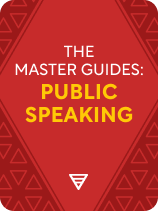

This article is an excerpt from the Shortform book guide to "The Master Guides: Public Speaking" by Shortform. Shortform has the world's best summaries and analyses of books you should be reading.
Like this article? Sign up for a free trial here.
How can you get better at public speaking? Are there strategies for how to give a better speech?
To become a great public speaker, you need to put thought into how you choose your topic, limit your speech to three key ideas, and create a strong opening and closing. By planning your speech strategically, you can send a more powerful message and connect better with your audience.
Learn how to become a great public speaker with this expert advice.
First Steps Towards Becoming a Great Public Speaker
Does the thought of speaking in front of an audience make you anxious? You’re not alone: Many people say they fear public speaking even more than death. But public speaking is also one of the most important and widely applicable skills in life, and the good news is, anyone can learn how to become a great public speaker. By learning proven skills and techniques, you can become an effective communicator and confidently deliver your message to an audience.
We’ve compiled leading experts’ insights on how to prepare and deliver your speech. Whether you want to persuade, inform, entertain, or motivate your audience, this article will walk you through the process of crafting and delivering a powerful speech that captures your audience’s interest.
We’ll begin by exploring the preparation phase—how to plan, write, and rehearse your speech. Then, we’ll describe tips for delivering your speech to an audience and keeping them engaged.
How to Prepare Your Speech
First, let’s dive into the preparation work for your speech. In Public Speaking for Success, author and lecturer Dale Carnegie contends that the best speeches are extensively prepared ahead of time. In this section, we’ll look at various experts’ tips on how to:
- Choose a topic
- Structure and write an engaging speech
- Practice to boost your confidence and performance
Choose a Topic
Carnegie recommends that when choosing a speech topic, look for one that you’re both passionate and knowledgeable about, as a powerful speech is one that blends emotion and reason. Your emotions will fuel and animate your speech-giving, while your rock-solid information will persuade even the most intelligent and discerning audiences.
In The 16 Undeniable Laws of Communication, John C. Maxwell suggests additional tips for choosing a topic that gives you credibility:
Tip 1: Ensure your message matches your true beliefs. To be credible in the eyes of others, you must genuinely believe in the message you’re delivering. When you’re confident in your message, you naturally use more powerful language and convey more emotion. Your audience will be more open to listening to you when they believe your words are sincere.
While it’s important for your message to match your true beliefs, persuasion and rhetoric expert Jay Heinrichs says in Thank You for Arguing that it’s more important to match the values of your audience. When your audience believes that you share the same values as they do, they see you as someone virtuous, or trustworthy and aligned with their cause.
Tip 2: Support your words with your actions. Maxwell advises you to follow your own advice before giving it to others. For example, if you argue that organization is key to productivity, but you display an obvious lack of organization, your audience won’t be receptive to your message.
Write Your Speech
Carnegie adds that speeches tend to have one of four common goals:
- To elucidate and educate
- To persuade people of a position
- To inspire people to take action
- To captivate and entertain
When choosing your talking points, you use the Rule of Three: Include a maximum of three ideas in any one speech. Research suggests that the brain can’t process more than three ideas at once, so if you add any more than this to your talk, your audience simply won’t remember them.
Experts also suggest creating a message map—a one-page summary of everything you want to include in your talk—to help you plan so you know going into your speech what you’ll cover.
Create a Strong Opening
You only have about 60 seconds to keep your audience’s attention once you begin your speech. Try saying something dramatic within the first minute, show a fascinating image (this can be beautiful, confusing, or funny), or pique their curiosity with a question or counterintuitive statement.
Likewise, Carnegie recommends you keep your opening succinct by refining it to a sharp, powerful sentence or two. He adds that there are several weak ways of opening a speech that you should avoid:
- Don’t open with an apology. Often used to seem humble, this technique makes speakers look incompetent or unprepared and can annoy audiences.
- Don’t open with humor. Most speakers can’t pull off jokes, so you’ll most likely make the audience cringe and pull away emotionally.
- Don’t open too formally. Scripted, overly rehearsed, and/or dry openings easily lose the audience’s attention.
Express Your Ideas Simply
Many experts suggest you express your ideas simply when writing your speech, which, as Maxwell explains, allows your audience to better understand and remember them.
In The Bezos Blueprint, Carmine Gallo offers tips you can use to keep your speech simple and clear:
Tip 1: Use simple language. Express your ideas simply enough that the average high school student could understand them. Maxwell expresses a similar sentiment but suggests using language that an eighth grader can understand.
Tip 2: Vary sentence length and structure, but use short sentences and simple words most of the time. The more complex, important, or stressful the subject matter, the more important it is to write plainly. Choose words of Anglo-Saxon origin rather than those of Latin or Greek origin—for example, a Latinate word might facilitate your efforts to sound smart, but an Anglo-Saxon word will help your audience understand you.
Tip 3: Use active language. Begin sentences with clear subjects and vivid verbs. This keeps the “action” moving and keeps your audience engaged.
Tip 4: Trim unnecessary words and ideas. Keep sentences short and direct by avoiding qualifiers and hedge words—they add fluff and feel indecisive. Likewise, Maxwell says you should trim excess information that might distract from your main points.
Incorporate Engaging Content
To make your ideas more understandable and to captivate your audience, experts recommend that you incorporate a variety of engaging content into your speech. Let’s look at several ways you can do this:
Strategy 1: Tell stories. In How Highly Effective People Speak, competitive public speaker Peter D. Andrei explains that people understand the world through stories—it’s how we learn and how our ancestors passed down information over thousands of years. When an argument is presented as a story, we relate to the people in the story and imagine what it would be like if the same things happened to us.
Strategy 2: Use visuals. Maxwell suggests you use body language, visual metaphors, or actual visual aids like physical props and images to help illustrate your ideas. Andrei explains that memories based on visual perception stick out more clearly in our minds, so they’ll provoke a stronger emotional reaction and be easier to recall later.
Strategy 3: Engage multiple senses. Gallo recommends presenting content that triggers a combination of the senses of hearing, sight, and touch. It’ll help your audience to remember what you’ve said: Research has shown that multisensory experiences are much more memorable than single-sense experiences. For example, if you’re pitching a product, you could pass a prototype around your audience.
Strategy 4: Incorporate humor: Maxwell writes that getting your audience to laugh increases feelings of intimacy and makes them more receptive to your words. However, he suggests you only use humor if it comes naturally to you.
Create a Powerful Closing
An audience will remember a talk based on how it ends. Here are several options for powerful closings:
Closing 1: Apply what you’ve discussed to a broader situation. For example, “If this management style can transform Fortune 500 companies, imagine what it could do in the White House.”
Closing 2: Declare a personal mission. End your speech by making a proclamation about how you are going to use this knowledge to improve the world.
Closing 3: Leave your audience with a dream. Paint a picture of a better world. Inspire your audience with your dream for the future—but be sure to avoid clichés.
Closing 4: Call them to action. Ask your audience to take the information you just gave them and do something with it. For example, “If we all contact our congressmen, they’ll have to listen.” Maxwell offers another tip for encouraging action: Help your audience imagine what the positive change looks like and show them how to take the first step.
Closing 5: End with beautiful language. A poetic statement, song lyric, or eloquent phrase can add a somber and memorable touch. Carnegie recommends using a famous quote if it more powerfully sums up your argument than you could.
How to Deliver Your Speech
Once you’ve written your speech, rehearse it so you can deliver your ideas clearly and confidently. Carnegie recommends you memorize your speech. This doesn’t necessarily mean learning each exact word and phrase by heart, but instead thoroughly learning your argument so you can speak extemporaneously.
Gallo suggests you focus on three things when practicing your speech:
- The speed at which you talk
- Confident body language
- Hand gestures
Manage Stress and Anxiety
It’s normal to feel nervous and release adrenaline before your speech, even if you’re a seasoned speaker. In TED Talks, Chris Anderson explains that adrenaline can be good: It gives you energy and animates your voice. However, in large doses, it can also make you shaky, give you dry mouth, and cause anxiety. He gives some tips for managing your nerves before you step out on stage:
Tip 1: Get active. If your adrenaline is high enough to make you shaky, do something physical to get rid of the excess.
Tip 2: Drink five to six ounces of water five minutes before you speak.
Tip 3: Focus on your breathing in the minutes before speaking.
Shortform Resources
For more tips on public speaking and effective communication, see the following Shortform guides:
- TED Talks, Chris Anderson
- Talk Like TED, Carmine Gallo
- The Bezos Blueprint, Carmine Gallo
- The 16 Undeniable Laws of Communication, John C. Maxwell
- Public Speaking for Success, Dale Carnegie
- Thank You for Arguing, Jay Heinrichs
- How Highly Effective People Speak, Peter D. Andrei
- Amplify Your Influence, René Rodriguez
- Simply Said, Jay Sullivan
Exercise: Prepare for an Upcoming Presentation
Now that you’ve learned the process of brainstorming, writing, and delivering a speech, think about how you can apply the techniques we discussed in the guide to a future presentation.
- Think of a speech or presentation you have to give. If you have the freedom to choose the topic, what are some topics you’re passionate about? If you have to follow a given topic, what are some aspects of that topic that you find interesting or exciting?
- Consider the various techniques for making your speech engaging (telling stories, using visuals, engaging multiple senses, and using humor). Write down one or two that resonate the most with you and your topic. How might you use these techniques in your speech?
- Describe how nervous you feel about public speaking. What is one strategy you can focus on to manage your stress and anxiety for your next presentation?

———End of Preview———
Like what you just read? Read the rest of the world's best book summary and analysis of Shortform's "The Master Guides: Public Speaking" at Shortform.
Here's what you'll find in our full The Master Guides: Public Speaking summary:
- How you can master public speaking—even if you fear it more than death
- Insights from leading experts on how to prepare and deliver a speech
- How to keep your audience's attention and stop them from losing focus






